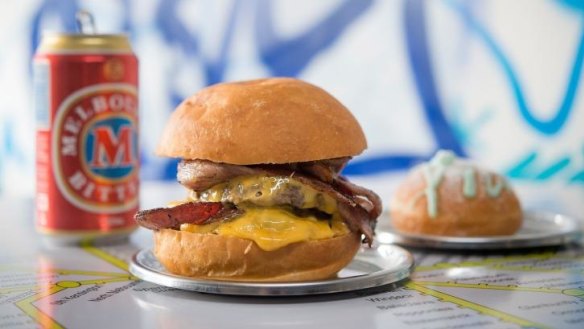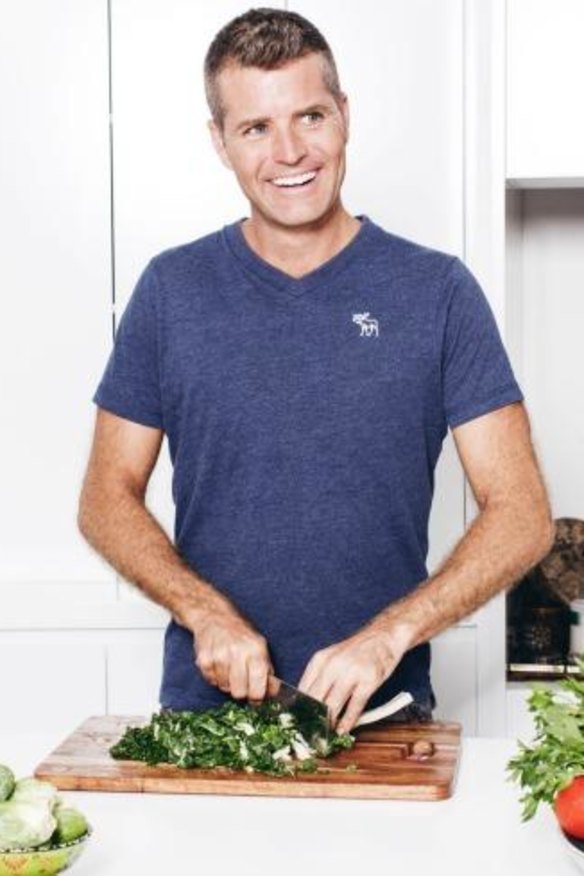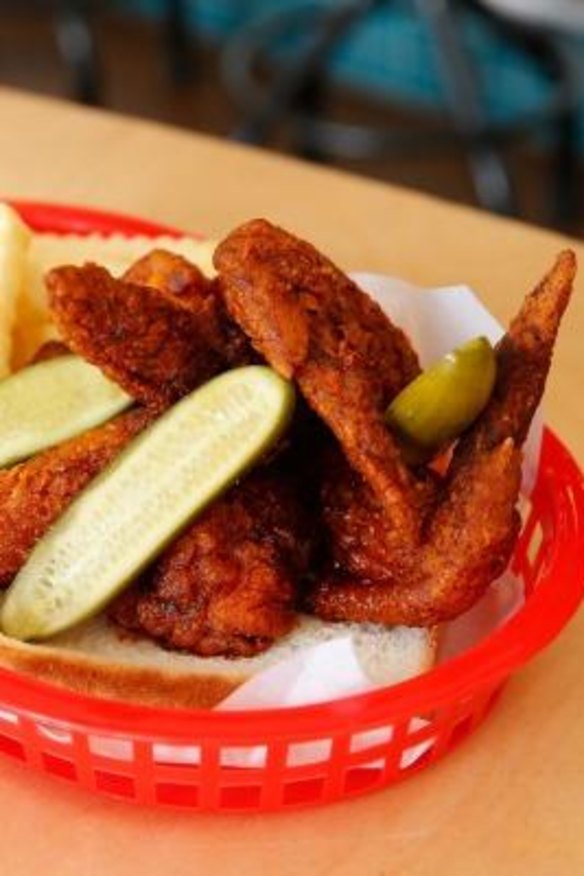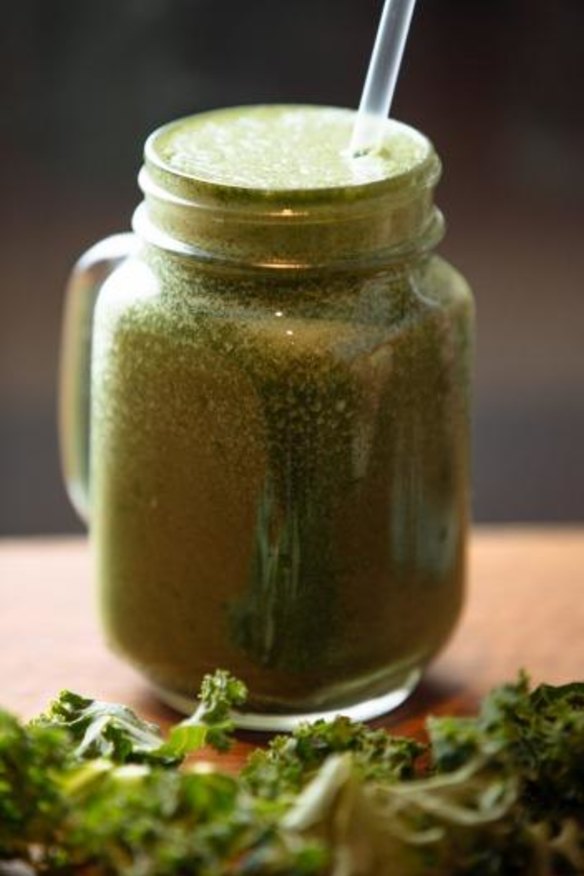Burgers v kale smoothies: The rise of extreme food

Easey's burger bar opened on a rooftop in Collingwood in late April. It sells fried chicken crumbed in Frosties for breakfast and a double-beef burger with a dim sum and potato cake at lunch. There is not a salad leaf in sight.
On the ground floor of the same building is Fare, a raw-focused wholefoods cafe selling almond milk smoothies and fermented brown rice risotto.

In terms of dining trends, this yin and yang concept could hardly be more "now".
For every kale smoothie posted on social media someone else is uploading a fat-dripping burger. For every KFC Double Down burger there's a gluten-free wrap.
For every salad in a jar there's a new fried chicken joint and each time Pete Evans activates an almond, another cronut comes out of the oven.

The balanced diet is dead. Extreme is the new norm.
Or at least that's the way things are heading. A Nielsen report published in January titled We Are What We Eat: Healthy Eating Trends Around the World shows that between 2012 and 2014, the global sales of both healthy and indulgent foods increased while sales of semi-healthy food declined.
What's going here? What happened to good ol' meat and three veg dinners with a bit of buttered bread on the side? I felt it was time to investigate our growing obsession with eating to the extreme.

STREAMING GAME OF THRONES MAKES YOU EAT BACON GELATO
In our busy, choice-rich lives, consumers are abandoning the middle ground and living in extremes. So says LS:N Global, a trend forecasting network developed by London-based consultancy group The Future Laboratory. The group describes these new lifestyle patterns - abstinence and indulgence, shopping and saving, fasting and gorging - as "the polarity paradox".
"Rather than trying to live in a constant state of denial, people are adopting more of a boom and bust approach to living," LS:N Global's food and drink specialist, Daniela Walker, says.
"They are eschewing bland experiences in favour of things that push them to an extreme. This can sometimes be a challenging, or even unpleasant, extreme, but in the polarity paradox these will be balanced out with pleasurable experiences in a way that ensures people remain stimulated."
Walker says digital media is a big driver of the phenomenon. "So much of our lives are spent online now, gazing into a screen that is flat in more ways than one. Our senses are left understimulated and so real world experiences need to be anything [other] than bland."
So the next time you request another beef patty, go on a fast or queue for bacon gelato, it might be because you've spent too long staring at the computer, binge-watching Game of Thrones, buying owl necklaces on Etsy and reading articles such as this one.
INSTAGRAMMING TOAST IS SOCIAL (MEDIA) SUICIDE
Social media is also a significant driver of extreme eating, Walker says.
"The 'sportification' of food is a pronounced trend, where people are competing for attention through Instagram and other social media platforms," she says.
"Your reflection on the internet is now at least as important as your reflection in the bathroom mirror. The whole 'food porn' phenomenon is driven by this."
Food blogger Helen Yee, the brains behind Grab Your Fork, confirms that photos guaranteed to get "likes" on her Instagram feed are usually deep-fried, covered in cream or loaded in sugar.
"It can be hard not to get caught up in the chase for likes," she says. "I know of people who delete a photo if it doesn't get enough likes on their feed and having a blip on their 100-plus average likes is just, well, embarrassing."
Similarly, food blogger and writer Lee Tran Lam says her most popular Instagram posts were either "really monumental" items such as a five-layer raspberry mousse and lemon curd cake or at the other end of the spectrum, pictures of salad.
"Is it just a coincidence that 'YOLO' [you only live once] and 'clean eating' have both became popular and much mocked hashtags?" she asks. "Eating in the extreme is a surefire way to draw attention to yourself and living your life in a hashtag-friendly way probably doubles-down on that limelight."
ARE GYM SELFIES RESPONSIBLE FOR FRANKENFOODS?
Writer, DJ and chef Andrew Levins says he hasn't seen much overlap between the "gym-selfie squad" and "deep-fried Cornetto brigade", but suggests the popularity of extreme junk food on social media is a retaliation against the green-juice guzzling fitness crew.
"Some people post a video of them doing 400 squats and getting a new PB [personal best]," he says.
"It gains them 100 likes and a handful of comments like 'Damn!', 'Lookin' good!', and 'Would!' that makes them feel better about themselves.
"A less healthy friend will see that video and think, 'I want 100 likes and a handful of comments but I hate exercise. What's the complete opposite of 400 squats?'. The answer to that question is a quadruple beef burger with doughnuts for buns and covered in a different kind of PB: peanut butter."
WOULD YOU LIKE FRIES WITH YOUR KALE?
Even the big fast-food outlets seem to have caught onto the trend. McDonald's is trialling kale on the menu, right alongside double quarter pounders. Red Rooster has partnered with SumoSalad and KFC launched a concept store in Parramatta that sells oversized Zingers alongside grilled chicken with quinoa.
"Food today is marketed as appealing to our health obsession with items like kale, smoothies and activated almonds - or as guilty pleasures such as the 'heart attack' burger," says Louise Adams, a clinical psychologist specialising in eating, weight and body issues.
"These polarities reflect our own polarised relationship with food ... It is essentially about wanting to have it all."
EXTREME EATING IS NOT HEALTHY
Snapchatting ice-cream sandwiches and consuming burgers by the kilo is certainly against doctor's orders, but restrictive dieting isn't the healthiest thing either.
Walker points to the recent popularity of the 5:2 diet as an obvious example of food extremism, where devotees of the diet fast for two days a week and eat regular food for the other five. "Flexitarianism is another example," she says. "Where people want to live essentially healthy lives, but also occasionally want to cheat and indulge."
Paleo, sugar-free and gluten-free diets are big business. Ever noticed how devotees often have an obsessed glint in their eye? That's because there's a good chance they are obsessed.
"Psychologically, we know that when people diet and restrict themselves to only 'healthy' foods, their relationship with food changes," says Adams.
"Without deprivation, we can enjoy a relaxed and moderate relationship with food that's flexible and not emotionally loaded. But, once we become restricted in our food choices, we get increasingly obsessed with food in general, and in particular, the types of foods we're not 'supposed' to be eating.
"This is a psychological reality which has been demonstrated in many studies - the more restricted we are, the more obsessed we become. We see it in eating disorders frequently, and now we're seeing it in the wider community. Food guilt is pervasive."
Adams says restriction of food is a well-established risk factor for binge eating.
"The more restricted we are, the more likely it is that we will break the rules and overdo it, eating large quantities of the forbidden food. People over-eat these types of food because they are hungry, because they are seeking satisfaction and because they are expecting to go back into the restriction phase so they decide to keep over-eating until that date, which is usually on a Monday."
Extremes never provide the answer, says accredited practicing dietitian Tania Ferraretto.
"There is evidence that restriction followed by bingeing can have detrimental effects on your long-term health and it is not an effective weight-loss measure.
"We want people to enjoy food, to eat something slowly and savour every mouthful. To choose to eat something when you want to but also to be able to stop because you are full or because you have had enough of the taste. Health is about variety, lots of vegetables, fruit, wholegrains and lean protein. There is nothing difficult, expensive or new in that."
So if you really want to shock your social media followers, the best thing you could probably do is post a picture of corned beef and vegetables with apple custard for dessert.
Just don't expect anyone to like it.
Restaurant reviews, news and the hottest openings served to your inbox.
Sign up- More:
- Restaurant news
